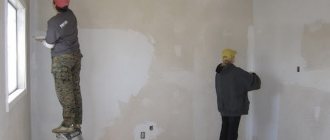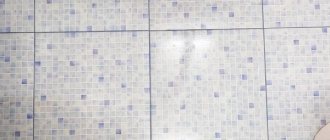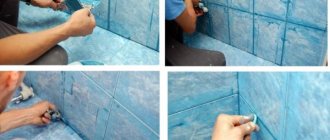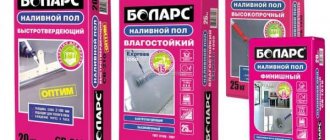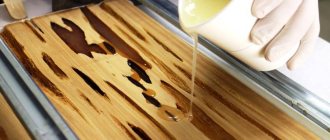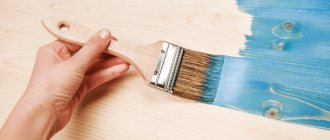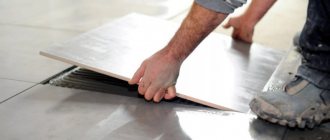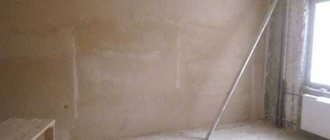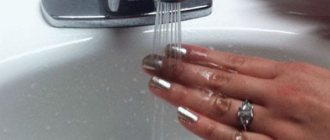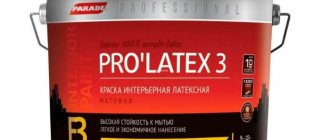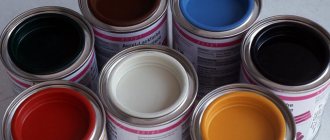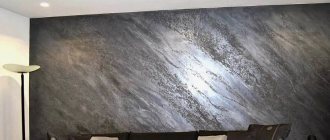Repair work is often delayed due to the long drying time of the plaster. After all, you won’t be able to move on to the next stage until the walls are completely dry. This fact forces builders to resort to compulsory processes. But how to do this so as not to harm the surface. If you approach the finishing stages correctly, you can make drying faster using dehumidifiers, the walls will not suffer from this.
What factors affect drying speed?
In fact, the drying speed is influenced by many factors: from the components of the plaster to the thickness of the layer.
But in order to delve into the topic of drying plaster in more detail, it is worth examining each of these parameters:
- type of plaster coating;
- features of the primer base;
- air humidity at the time of drying;
- general room temperature.
It is these factors that can be called the main ones influencing the drying speed of the plaster coating.
Reference! Additionally, you can study the manufacturer's notes on the packaging. It is there that the approximate drying times under certain conditions should be written.
Effect of layer thickness on drying speed
This is a completely logical point that directly affects the drying speed of the plaster. For example, if you take a thin layer of plaster, thanks to certain conditions it will dry quickly and efficiently. If the layer is thick, then, of course, it will dry much longer.
If we analyze the drying time using the example of a standard cement-sand composition, then under favorable conditions, after application, it will dry within two weeks. If you maintain the same favorable conditions, but the plaster layer is many times thicker, then it will take more than two weeks to dry.
Reference! Particular attention should be paid to the preparatory work that is carried out before leveling the walls.
Furniture items
A few examples of furnishing a kitchen combined with a living room:
- 1. Sofa. It becomes an object that zones space. The sofa is placed with its back facing the place where food is prepared. In small rooms (less than 20 sq m) a corner is placed, which is placed against a wall installed perpendicular or parallel to the kitchen.
- 2. Set. According to designers, minimalist models without elaborate details look modern. The service, vases or glasses are placed on an open shelf. You can buy a fashionable display case for them. Furniture is placed near the wall. If the space is large (20 sq. m, 25 sq. m or 30 sq. m), then in the central part you can install an island, which also has sections for kitchen appliances.
- 3. Furniture set. The style should be combined with the design of both rooms. In small rooms, a compact table and chairs made of transparent material or painted in light colors look good. You can add a table with a round top to your living room interior. In spacious rooms, the kit is installed near the wall or in the central part. An elongated rectangular dining table would look good here.
Time for complete drying of the plaster, depending on its type
Another important point is the type of plaster. The classification of varieties is determined by the main substances in the composition.
Depending on these substances, certain properties of the composition will depend, including the drying rate.
Plaster
This composition will dry within 5 days if favorable conditions are provided.
Important! The entire time the plaster is drying, the builder must ensure that the same temperature is maintained.
Due to the special qualities of the gypsum composition, all imperfections should be eliminated immediately. This plaster sets quickly and if any defects are observed, they cannot be corrected within a day; the composition will set 40 minutes after application.
Cement
This composition takes a very long time to dry. The average duration under favorable conditions is 14 days.
But if the layer is too thick, then the drying time may increase to 30 days. In this case, humidity should not exceed 70%.
Limestone
The lime composition will completely harden in one week. But drying time also depends on the provision of favorable conditions, as well as on the thickness of the layer. If you apply this mixture in a thin layer, complete drying will occur within a day.
Advice! If you add lime to the cement mortar, this will significantly reduce the drying time.
Acrylic
One of the fastest drying plaster bases. The first layer, if thin enough, will dry in one hour.
If the humidity level is very high, the waiting time will increase to three hours.
Decorative
It should be applied in a thin layer to already smooth walls. Drying time also depends on the main components of the composition, but most plasters will dry in 3-5 days.
Important! It is necessary to strictly monitor the thickness of the layer, only this will ensure proper drying of the decorative composition.
Multi-level floor
To zone the space, craftsmen install floors at different levels. They advise installing a podium to separate the kitchen and dining room. This option is considered one of the most practical because, among other things, the owners have additional free space where they can hide something.
It is convenient to use boxes or crates for this. Wicker baskets will look good. But such space can remain free.
For podiums, reliable materials are selected that can withstand heavy loads. Usually builders make wooden or metal podiums.
However, such a design should not be made if there are small children in the family, since the podium can become an obstacle for him. In addition, various floor coverings can be used.
They will zone the space between the living room and the kitchen and protect the podium from damage. For example, tiles are laid in the kitchen area, and laminate flooring in the dining room. The main thing is to choose colors and textures and combine the finishes correctly.
How long does it take for plaster to dry, depending on the base?
The surface on which the composition is applied also plays a big role.
Monolithic surface
It is not able to absorb moisture, therefore, the drying time of the plaster increases many times.
A thin layer of plaster composition at the optimal temperature will dry from 2 to 6 days.
Tree
Excellent air and heat permeability. A thin layer of plaster will dry within 14 hours if conditions are favorable.
Important! A layer of more than 2 centimeters will take 2 times longer to dry.
Brick
Excellent moisture transfer. The brick must be primed first, and this will increase the drying time.
For example, a layer of 2 centimeters under favorable conditions will harden in 10 days. If the walls are very crooked, then several layers are applied. But each layer is applied only after the previous one has dried.
Drywall
The material is very thin for applying plaster, so it will require additional strengthening.
Reinforcement of the surface is required, and a layer of 1 centimeter will dry within 1-2 days.
Expanded clay
Plaster on expanded clay blocks dries very quickly. They are able to withstand coating thicknesses from 1.5 to 5 centimeters. This layer will dry within a week.
But due to the special surface, the coating may crack. To prevent this, you need to systematically spray the surface with water.
Aerated concrete
The special surface of aerated concrete allows the plaster to dry quickly. Under favorable conditions and a relatively small layer of plaster, the walls will dry within 24 hours.
Zoning
Designers do not advise giving in to fashion trends and copying design ideas without taking into account dimensions, location and other nuances. Before planning and arranging furniture, every detail is thought through.
There are several simple rules that experts advise you to follow:
- Let the room have natural light. To do this, remove excess walls (except for load-bearing ones).
- If the rooms in the apartment are small (12 sq. m or 16 sq. m), the layout of the kitchen combined with the dining room will be the right solution.
- If the ventilation system is not designed correctly, the smell of food will spread throughout the apartment.
What are the features of drying?
Drying features are indicated depending on the environment where the plaster is drying.
Room
If the walls are plastered indoors, this will happen quite quickly, regardless of weather conditions.
For favorable conditions, it is enough to ensure optimal temperature and humidity. Most manufacturers write drying times for their compositions specifically for indoor environments.
Important! Do not forget that the cement-sand composition shrinks after application.
Street
Plastering work is best done in the summer. Under the influence of warm temperatures and normal air humidity, the plaster composition will dry much faster.
If the temperature is less than 15 degrees, this will increase the drying speed.
Ways to dry walls
We will provide several popular methods for drying plastered walls.
Ventilation
The ventilation path is the simplest and practically ineffective. Why?
- the option is relevant only in the warm season;
- humidity should not exceed 70%;
- you need a stable supply of air masses.
That is why the method is not effective.
Application of heat guns
Not a bad option, but it won't always work. Why?
- you cannot point the gun at the wall, otherwise the plaster will overheat and crack;
- ventilation is still needed to maintain the optimal temperature;
- constant adherence to temperature conditions;
- You can use the gun for no more than 6-8 days.
The method is budget-friendly, not bad, but not the best.
Application of dehumidifier
This method can be used always and everywhere. In this case, you do not need to constantly monitor humidity and temperature, and the device will ensure quick drying of the plastered surface.
JSC "Sinus" - eliminating the consequences of flooding, flooding and high humidity!
Sinus Dehumidification Academy is an expert in room dehumidification. We work with any objects: apartments, private houses, offices, production areas, roofs, basements, plinths, etc. Over the years, we have accumulated extensive experience in solving problems of flooding, flooding, mold, etc. For each specific case, we select an effective solution so that dehumidification is 100% effective.
Our team of specialists can be called at any time: we work 24/7. The team arrives 30 minutes after the application. We use only certified drying equipment. No heat guns or ineffective methods. We know how to dry walls after flooding, call us.
Prices for drying services
| Service | Price | Price per 1 m2 |
| Express drying | On request | — |
| Removing mold and mildew | 350 rub. | 350 rub/m2 |
| Dehumidification of one room | 2500 rub. | 300 rub/m2 |
| Drying ceilings: suspended and suspended | 2600 rub. | 300 rub/m2 |
| Drying a plasterboard ceiling | 4,000 rub. | 300 rub/m2 |
| Drying wet spots on walls | 2400 rub. | 250 rub/m2 |
| Draining walls | 2300 rub. | 300 rub/m2 |
| Removing water from the floor or under the floor | 2000-3000 rub. | 250 rub/m2 |
| Drying under parquet | 4,000 rub. | 300 rub/m2 |
| Drying the laminate | 3,000 rub. | 290 RUR/m2 |
| Drying damaged furniture | 3,000 rub. | — |
| Antifungal treatment of any surfaces | 3,000 rub. | — |
| Drying plaster or screed after repair | 3,000 rub. | 300 rub/day |
| Drying of building materials (concrete, wood) | 2,500 rub. | — |
| Comprehensive drying of country houses | 5,000 rub. | — |
Drying is much cheaper than repairing! Call right now +7 968 082-31-29, +7 495 681-73-61.
How to dry walls in winter
In winter, this procedure is quite problematic. What to do in such a situation?
Compliance with conditions
When applying plaster to walls in winter, certain conditions must be observed:
- monitor the humidity of the walls;
- ensure favorable room temperature;
- carry out preparatory work correctly;
Once these conditions are met, you can proceed to the next step.
Relationship between plaster and frost
If you have to plaster the walls in severe frost, then there is an unusual life hack. You can add a chemical to the composition and not worry about the temperature in the room and freezing of the walls.
Chlorine
If you add chlorine, then plastering work can be done even at -25 degrees. True, such water needs to be heated to 35 degrees and only then add lime to the water.
Application of potash
This method is only suitable for reinforced walls. The composition is used primarily for cement mortars.
Important! Potash does not cause metal corrosion and can be applied directly to the mesh.
Ammonia bases
If you use ammonia, you can carry out plastering work even at -30 degrees.
Important! To prevent ammonia from dissolving, the temperature of the liquid should not exceed 5 degrees.
Content:
- The structure of plaster, its features and the main errors that occur during drying
- How to dry plaster or putty in the room being treated?
- Drying plaster and walls with a dehumidifier - a real example
- conclusions
Everyone finds a certain method for solving the issue, but we will discuss all possible methods and decide how to dry the walls correctly and in what sequence to do it. But first you need to understand the main thing - it is possible, and even necessary, to dry the walls during repairs, and it is advisable to do this at every stage of construction or finishing.
